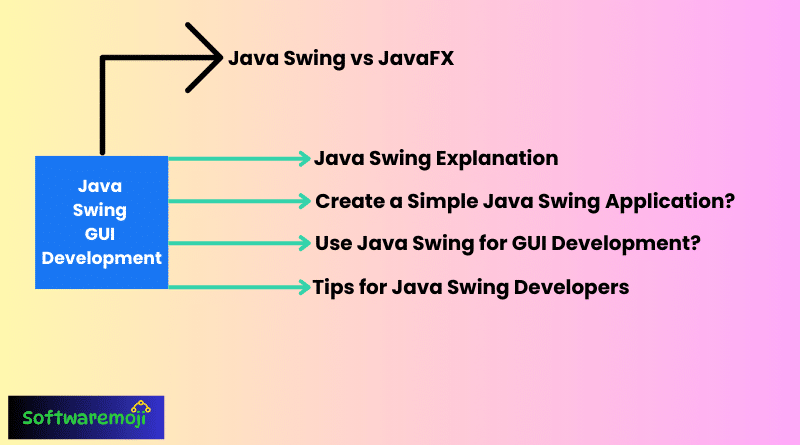
✅Java Swing GUI Development:
- Java Swing is a powerful toolkit for building graphical user interfaces (GUIs) in Java, providing developers with versatile and customizable UI components.
- By using Java Swing, developers can create cross-platform applications that run seamlessly on various operating systems like Windows, macOS, and Linux.
- Swing GUI development enables the creation of rich, interactive interfaces with support for features like buttons, tables, sliders, and text fields.
- One of the main benefits of using Swing for GUI development is its ability to separate the logic of the application from the interface, promoting a clean architecture.
- Java Swing offers a lightweight and platform-independent environment for building desktop applications, making it a popular choice for enterprise-level software.
- With Swing’s MVC (Model-View-Controller) architecture, developers can efficiently manage and update the user interface without affecting the core functionality.
- Java Swing comes with a comprehensive set of widgets like menus, toolbars, and dialogs, allowing developers to create feature-rich desktop applications.
- For modern UI design, Java Swing supports customization and theming, allowing developers to create sleek, visually appealing user interfaces.
- Swing’s event-handling model makes it easy to respond to user interactions like clicks, keystrokes, and mouse movements, ensuring smooth and responsive GUI applications.
- By leveraging Swing’s layout managers, developers can easily design flexible and adaptable GUIs that work well across different screen sizes and resolutions.
✅Java Swing GUI Development What is Java Swing?
Java Swing is a popular Graphical User Interface (GUI) toolkit used for building interactive desktop applications in Java. It is a part of Java Foundation Classes (JFC) and extends the capabilities of Abstract Window Toolkit (AWT) by providing lightweight, platform-independent UI components.
With Swing, developers can create responsive and visually appealing applications with elements like buttons, text fields, tables, menus, and more.
✅Java Swing GUI Development Why Use Java Swing for GUI Development?
✅ Platform Independence – Runs on Windows, Mac, and Linux.
✅ Rich Set of Components – Includes advanced UI elements like trees, tables, and tabbed panes.
✅ Customizable Look and Feel – Supports themes and skins.
✅ Event-Driven Programming – Provides easy handling of user actions.
✅ Integration with MVC Architecture – Helps in building scalable applications.
✅Java Swing vs JavaFX: Which One to Choose?
While Swing is widely used for GUI development, JavaFX is the modern alternative offering better UI controls, CSS styling, and multimedia support. If you are building lightweight desktop applications, Swing is still a great choice. However, for modern, interactive, and media-rich applications, JavaFX is preferred.
✅How to Create a Simple Java Swing Application?
Follow these steps to build a basic GUI application in Java using Swing:
✅Step 1: Import Required Packages:
javaimport javax.swing.*;
✅Step 2: Create a JFrame Window:
javaJFrame frame = new JFrame("My First Java GUI");
frame.setSize(400, 300);
frame.setDefaultCloseOperation(JFrame.EXIT_ON_CLOSE);
✅Step 3: Add Components (Buttons, Labels, etc.):
javaJButton button = new JButton("Click Me");
frame.add(button);
✅Step 4: Make the Frame Visible:
javaframe.setVisible(true);
✅Java Swing GUI Development Tips for Java Swing Developers:
If you are writing a Java Swing tutorial or a blog post, follow these best practices to improve visibility on search engines:
🔹 Use Keyword-Rich Titles – Example: “How to Create a GUI in Java Using Swing (Step-by-Step Guide)”
🔹 Optimize Meta Descriptions – Add a concise summary (150-160 characters) with keywords.
🔹 Include Code Examples – Search engines favor content with practical examples.
🔹 Use Headings & Bullet Points – Helps in readability and ranking.
🔹 Internal & External Links – Link to official Java documentation and related tutorials.
🔹 Add FAQs – Answer common questions like “Is Java Swing still used?”
✅Java Swing GUI Development Final Thoughts:
Java Swing remains a powerful toolkit for GUI development, especially for enterprise applications and projects where JavaFX is not necessary. With the right strategy, your Java Swing tutorials can rank higher and reach more developers.
🚀 Start coding your first Java Swing application today!
